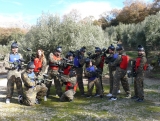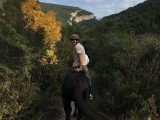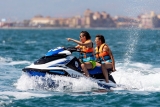The wonderful thing about adventure sports is that they reveal unique opportunities to encounter animal and plant species. If possible, we highly recommend going on a diving excursion, as you'll reach places like the Mediterranean Sea where you can find animals such as the monk seal, scientifically known as Monachus monachus.

Distribution Area
The original distribution area of this marine mammal encompassed all coastal waters of the Mediterranean Sea and its adjacent Atlantic regions: the Canary Islands, Madeira, Western Sahara and Mauritania. However, currently, its population has dramatically declined and survives only in specific locations within its former range. While exact numbers remain uncertain, the current global population is estimated at 400-500 individuals, primarily distributed across three geographical zones: the eastern Mediterranean (Greek and Turkish islands, with about 200 specimens); the western Mediterranean (Algeria and Morocco, with an estimated maximum of 20-50 specimens), and Western Sahara (approximately 200 individuals).
Until a few decades ago, the monk seal was still present along all Spanish coasts. Historically it was an abundant species that formed colonies of several thousand individuals in places like Lobos Island off Fuerteventura. Chronicles tell how sailors bound for the Americas would stop there to hunt seals for oil and meat provisions before crossing the Atlantic.
Evidence of the monk seal's former abundance can be seen in the numerous coastal place names across Spain that reference the species, known regionally as: lobo marino, llop marí, vellmarí, ca marí, etc. They could more frequently be enjoyed through cetacean watching.

What has happened to the monk seal population? What factors have driven it to the brink of extinction?
For about thirty years, the species' decline has been widely reported. The story of the monk seal is one of predicted extinction. Meanwhile, the population has decreased dramatically and disappeared from Spanish coasts due to the inability and indifference of our authorities and their technicians, who have done nothing to prevent it.
Several factors have caused the species' decline:
- Human persecution
- Mediterranean pollution
- Human pressure on coastal areas
- Overfishing and resource depletion
Of these, direct persecution remains undoubtedly the primary cause of decline.
Fishermen have historically viewed this magnificent animal as a harmful beast that depleted fish stocks and damaged fishing gear. Most records of the species this century refer to hunting activities.

Recovery efforts
Faced with this bleak outlook, we examine recovery measures and wonder whether the species can regain its former status or at least be preserved. About twenty years ago, the first working groups were established to study the species' biology and implement protection and recovery measures.
Addressing monk seal recovery possibilities in an article like this, concisely and specifically, proves difficult due to the complexity. The main obstacle to establishing comprehensive recovery measures lies in diverging opinions among different working groups. For years, discussions have included captive breeding, relocating specimens to protected areas to establish new populations, transferring pups to recovery centres, etc.

But to date, little progress has been made, partly due to limited knowledge about this marine mammal's biology and partly because of an insurmountable barrier: the critically low number of remaining specimens. This makes it difficult to assess whether proposed solutions might worsen the situation: removing specimens from existing groups risks destabilising the donor population.
The terrible reality is we're in a race against time. While experts debate appropriate measures, populations continue dwindling. About two years ago, some two hundred specimens died off the Saharan coast due to a red tide. Although natural in cause, this catastrophic mortality event could prove fatal if the population fails to recover.
Realistically assessed, our monk seal's present and future appear this precarious. The species' recovery chances appear minimal. Should monk seal extinction occur, we'll lose part of ourselves, our culture, and an important piece of our beloved yet mistreated Mediterranean.

One inevitably wonders whether coexistence between humans and monk seals remains possible in the Mediterranean. Hypothetically, if populations recovered, could cohabitation occur? To answer this, we need only look to other regions like California's coasts. There, seals and sea lions aren't persecuted; indeed, humans have installed harbour platforms specifically for their rest and recreation.
We bid farewell to this magnificent animal, whose populations we've decimated, dreaming of an perhaps impossible future where monk seals again swim the Mediterranean's crystalline waters and bask on its sandy shores.











